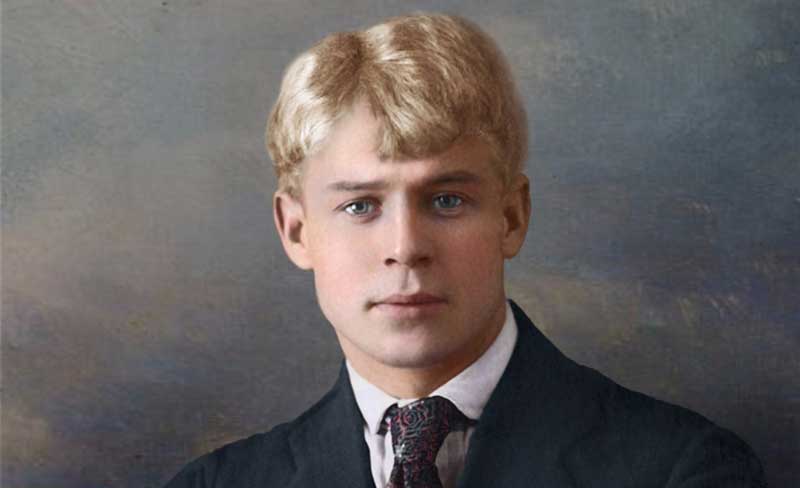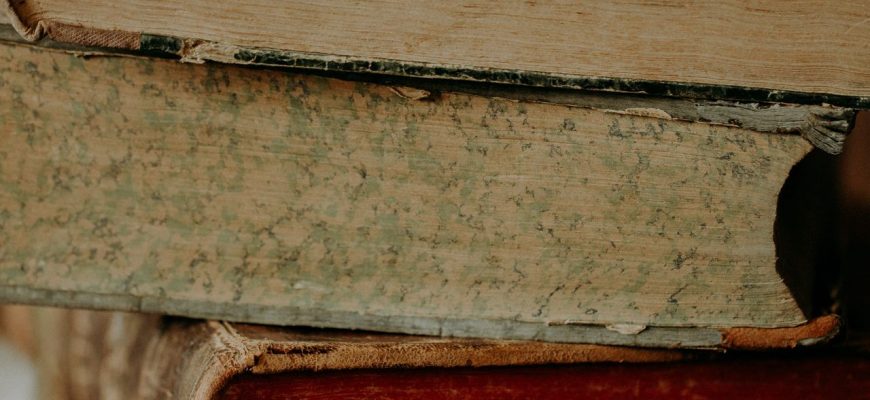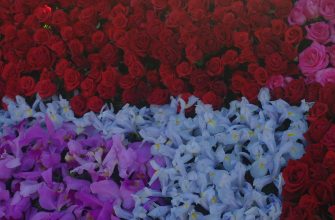Биография Сергея Есенина на английском языке
Здесь вы можете прочитать биографию Сергея Есенина на английском языке.

In 1912 he moved to Moscow and found a job. At first Yesenin worked in a bookshop and then in the printing establishment. A year later he entered Moscow State University and attended there for eighteen months. Russian folklore affected Yesenin’s early poetry. In 1915, a young poet moved to St. Petersburg and met Andrei Bely, Alexander Blok, Nikolai Klyuev and Sergey Gorodetsky there. It is known that Alexander Blok tried his best to promote Sergey Yesenin as a poet.
The first Yesenin’s book was published in 1916. It was called Radunitsa. Yesenin became one of the most famous poets in those days for his touching poesy about simple life and love. In 1913 he married Anna Izryadnova who was his colleague in the publishing house. They had a son.
When Yesenin moved to St. Petersburg he became acquainted with Klyuev who became his close friend. They lived together for some time. In 1916 he was drafted into the army till 1917. Yesenin was also confident that the October Revolution would be an incitement for a better life and he supported it but later was disappointed. Yesenin occasionally criticized the Bolshevik rule in his works.
In 1917 he married Zinaida Raikh who was an actress. It was his second marriage. They had 2 children, Tatyana and Konstantin. Subsequently Sergey and Zinaida fell out and did not live together. In 1921 they divorced. Their son became a prominent soccer statistician and Tatyana became a writer.
In September 1918, Yesenin founded his own publishing house called «Трудовая Артель Художников Слова».
In 1921 he made the acquaintance of Isadora Duncan who was a dancer, eighteen years his senior. She did not speak Russian and Sergey did not know foreign languages. In 1922 they married. He accompanied Isadora on a tour of Europe and the USA but his dipsomania was out of control. Yesenin often razed hotel rooms and made a disturbance in public places. These facts surfaced in the international press. This marriage was not long and in 1923 he arrived in Moscow. After a while Yesenin met Augusta Miklashevskaya who was an actress. He was in a relationship with her.
Yesenin also had a son by Nadezhda Volpin that year. She was a poet. His son, Alexander Esenin-Volpin, became a poet too. Afterwards he left the USSR and became a mathematician in the USA. Sergey Yesenin did not know him.
The last 2 years Yesenin was addicted to drink but at the same time he wrote some of his best poems. In 1925 he married Sophia Andreyevna Tolstaya who was a granddaughter of Leo Tolstoy. She was his fifth wife. She tried to help him jolt out of his depression.
His last poem was written in his own blood. The next day Yesenin hanged himself in the Hotel Angleterre at the age of thirty. Yesenin was buried in Moscow’s Vagankovskoye Cemetery.
English2017
Английский для всех простым языком
Сергей Есенин — биография на английском с переводом

Sergey Yesenin Autobiography
In 1904 Yesenin joined the Konstantinovo zemstvo school. In 1909 he graduated it with an honorary certificate, and went on to study in the local secondary parochial school in Spas-Klepiki. From 1910 onwards, he started to write poetry systematically; In all, Yesenin wrote around thirty poems during his school years. He compiled them into what was supposed to be his first book which he titled «Bolnye Dumy» — Sick Thoughts — and tried to publish it in 1912 in Ryazan, but failed.
He left his village at 17 for Moscow and later Petrograd (subsequently Leningrad, now St. Petersburg). In the cities he became acquainted with Aleksandr Blok, the peasant poet Nikolay Klyuyev, and revolutionary politics.
Yesenin’s first marriage (which lasted three years) was in 1913 to Anna Izryadnova, a co-worker from the publishing house, with whom he had a son, Yuri. 1913 saw Yesenin becoming increasingly interested in Christianity, biblical motives became frequent in his poems. That was also the year when he became involved with the Moscow revolutionary circles: for several months his flat was under secret police surveillance and in September 1913 it was raided and searched.
In 1916 he published his first book, characteristically titled for a religious feast day, Radunitsa (“Ritual for the Dead”).
From 1916 to 1917, Yesenin was drafted into military duty
In August 1917 Yesenin married for a second time, to Zinaida Raikh. They had two children, a daughter Tatyana and a son Konstantin. Tatyana became a writer and journalist and Konstantin Yesenin would become a well-known soccer statistician.
Yesenin supported the February Revolution. Later he criticized the Bolshevik rule.
In 1922 he married the American dancer Isadora Duncan. They visited the United States, their quarrels duly observed in the world press. On their separation Yesenin returned to Russia.
Yesenin married again, a granddaughter of Tolstoy, but continued to drink heavily and to take cocaine.
In 1925 he was briefly hospitalized for a nervous breakdown.
Died December 27, 1925 in St. Petersburg, Russia. On 28th December 1925, Yesenin was found dead in the room in the Hotel Angleterre in St Petersburg. He was buried December 31, 1925, in Moscow’s Vagankovskoye Cemetery. His grave is marked by a white marble sculpture.
He was a prolific and somewhat uneven writer. His poignant short lyrics are full of striking imagery. He was very popular both during his lifetime and after his death.
Перевод
В 1904 году Есенин вступил в Константиновское земское училище. В 1909 году закончил его с почетным дипломом и продолжил обучение в местной средней приходской школе в Спас-Клепики. С 1910 года начал писать стихи на постоянной основе. В целом, в школьные годы Есенин написал около тридцати стихотворений. Он собрал их в его первую книгу, которую назвал «Больные думы», пытался опубликовать книгу в 1912 году в Рязани, но потерпел неудачу.
В 17 лет он уехал из деревни в Москву, а затем в Петроград, впоследствии Ленинград, ныне Санкт-Петербург. Там он познакомился с Александром Блоком, крестьянином Николаем Клюевым и революционной политикой.
Первый брак Есенина, который длился три года, был в 1913 году с Анной Изрядновой, сотрудником издательства, с которой у него был сын Юрий. В 1913 году Есенин все больше интересовался христианством, в его стихах часто возникали библейские мотивы. Это был также год, когда он стал участвовать в московских революционных кругах: в течение нескольких месяцев его квартира находилась под наблюдением секретной полиции, а в сентябре 1913 года она подвергалась набегам и обыскам.
В 1916 году он опубликовал свою первую книгу, характерно названную для религиозного праздника Радуница — «Ритуал для мертвых».
С 1916 по 1917 год Есенин был призван в военную службу.
В августе 1917 года Есенин женился второй раз, на Зинаиде Райх. У них было двое детей, дочь Татьяна и сын Константин. Татьяна стала писателем и журналистом, а Константин Есенин станет известным футболистом-статистиком.
Есенин поддержал Февральскую революцию. Позже он подверг критике большевистское правление.
В 1920-21 годах он сочинил свою длинную поэтическую драму про Пугачева, прославляющую повстанца 18-го века.
Вскоре он стал ведущим лидером школы. Он стал завсегдатаем литературных кафе Москвы, где читал стихи и много пил.
В 1922 году он женился на американской танцовщице Айседоре Дункан. Они посетили Соединенные Штаты. Их ссоры отражались мировой прессой. После их развода Есенин вернулся в Россию.
Умер 27 декабря 1925 года в Санкт-Петербурге, Россия. 28 декабря 1925 года Есенин был найден мертвым в комнате в гостинице «Англетер» в Санкт-Петербурге. Был похоронен 31 декабря 1925 года на Ваганьковском кладбище в Москве. На его могиле белая мраморная скульптура.
Он был одаренным и неоднозначным писателем. Его острая короткая лирика полна ярких образов. Он был очень популярен как во время его жизни, так и после его смерти.
Тема Биография Есенина на английском языке: диалоги, сочинение
Поэзия – poetry [ˈpoʊətri]
Стихи – verse [vɜːrs]
-Кто такой Сергей Есенин? Who is Sergey Yesenin?
-Это великий русский поэт! This is a great Russian poet.
Биография/Biography
Детство/childhood
Родился 21 сентября (3 октября) 1895 года в с. Константиново Рязанской губернии в семье крестьянина.
Образование в биографии Есенина было получено в местном земском училище(1904-1909), затем до 1912 года – в классе церковно-приходской школы. В 1913 году поступил в городской народный университет Шанявского в Москве.
Born on September 21 (October 3), 1895 in the village of Konstantinovo, Ryazan province in a peasant family.
Education in the biography of Yesenin was obtained in the local Zemstvo school (1904-1909), then until 1912 – in the class of the parish school. In 1913 he entered the city people’s University of Shanyavsky in Moscow.
Начало литературного пути/The beginning of the literary path
Впервые стихотворения Есенина были опубликованы в 1914 году.
После публикации сборников («Радуница»,1916 г.) поэт получил широкую известность.
В лирике Есенин мог психологически подойти к описанию пейзажей и крестьянской Руси.
Начиная с 1914 года Сергей Александрович печатается в детских изданиях, пишет стихи для детей (стихотворения «Сиротка»,1914г., «Побирушка»,1915г., повесть «Яр»,1916 г., «Сказка о пастушонке Пете…»,1925 г.).
В это время к Есенину приходит настоящая популярность, его приглашают на различные поэтические встречи.
Yesenin’s poems were first published in 1914.
After the publication of collections (“Radunitsa”,1916) the poet became widely known.
In the lyrics of Yesenin could psychologically approach to the description of the landscapes and peasants of Russia.
Since 1914 Sergey Alexandrovich has been published in children’s editions, writes poems for children (poems “orphan”, 1914., “Beggar”, 1915., the story “Yar”, 1916, ” the Tale of the shepherd Petya…”,1925).
At this time, Yesenin comes to real popularity, he was invited to various poetic meetings.
Последние годы жизни и смерть/ The last years of life and death
В дальнейшем творчестве Есенина очень критично были описаны российские лидеры.
Осенью 1925 года поэт женится на внучке Л. Толстого – Софье Андреевне. Депрессия, алкогольная зависимость, давление властей послужило причиной того, что новая жена поместила Сергея в психоневрологическую больницу.
In the future work of Esenina very critical has been described by Russian leaders.
In the autumn of 1925 he married the granddaughter of Leo Tolstoy – Sofya Andreyevna. Depression, alcohol dependence, the pressure of the authorities was the reason that the new wife placed Sergei in a neuropsychiatric hospital.
Then in the biography of Sergei Yesenin there was an escape to Leningrad. And on December 28, 1925, Yesenin died, his body was found hanged in the hotel “Angleterre”.
Sergey Esenin Реферат
Реферат, выполненный школьницами 8 класса имеет практическую направленность. Информация на английском языке о Сергее Есенине, перевод стихотворения можно использовать на уроке, изучая тему- «Выдающиеся люди России.»
Просмотр содержимого документа
«Sergey Esenin Реферат»
по английскому языку в 8 классе, учебник « Spotlight”, модуль 3.
по теме «выдающиеся люди России»
выполнили учащиеся 8 «В» класса:
учитель английского языка: Игнатьева О.А.
Sergey Esenin was born in Konstantinovo in the Ryazan Province ( Gubernia) of the Russian Empire to a peasant family. He spent most of his childhood with his grandparents, who essentially reared him. He began to write poetry at the age of nine.
In 1912, Esenin moved to Moscow, where he supported himself working as a proofreader in a printing company. The following year he enrolled in Moscow Charnyavsky University as an external student and studied there for a year and a half. His early poetry was inspired by Russian folklore. In 1915, he moved to Petrograd, where he became acquainted with fellow-poets Alexander Blok, Sergey Gorodetsky, Nikolai Klyuev and Andrei Bely and became well known in literary circles. Blok was especially helpful in promoting Yesenin’s early career as a poet. Yesenin said that Bely gave him the meaning of form while Blok and Klyuev taught him lyricism.
In 1916, Yesenin published his first book of poems, Radunitsa (Russian). Through his collections of poignant poetry about love and the simple life, he became one of the most popular poets of the day. His first marriage was in 1913 to Anna Izryadnova, a co-worker from the publishing house, with whom he had a son, Yuri.
From 1916 to 1917, Yesenin was drafted into military duty, but soon after the October Revolution of 1917, Russia exited World War I. Believing that the revolution would bring a better life, Yesenin briefly supported it, but soon became disillusioned. He sometimes criticised the Bolshevik rule in such poems as The Stern October Has Deceived Me.
In August 1917 Yesenin married for a second time to Zinaida Raikh (later an actress and the wife of Vsevolod Meyerhold). They had two children, a daughter Tatyana and a son Konstantin. The parents quarreled and lived separately for some time prior to their divorce in 1921. Tatyana became a notable writer, and Konstantin Yesenin would become a well-known soccer statistician.
In September 1918, Yesenin founded his own publishing house called
(the «Labor Company of the Artists of the Word»). Together with Anatoly Marienhof, they founded the Russian literary movement of imaginism.
In the fall of 1921, while visiting the studio of painter Georgi Yakulov, Yesenin met the Paris-based American dancer Isadora Duncan, a woman 18 years his senior. She knew only a dozen words in Russian, and he spoke no foreign languages. They married on 2 May 1922. Yesenin accompanied his celebrity wife on a tour of Europe and the United States. His marriage to Duncan was brief and in May 1923, he returned to Moscow.
In 1923 Yesenin became romantically involved with the actress Augusta Miklashevskaya to whom he dedicated several poems. The same year he had a son by the poet Nadezhda Volpin. Their son, Alexander Esenin-Volpin grew up to become a poet and a prominent activist in theSoviet dissident movement of the 1960s. He lives in the United States, a famous mathematician and teacher.
In 1925 Yesenin met and married his fourth wife, Sophia Andreyevna Tolstaya, a granddaughter of Leo Tolstoy.
On 28 December 1925 Yesenin was found dead in his room in the Hotel Angleterre. His last poem Goodbye my friend, goodbye (До свиданья, друг мой, до свиданья) according to Wolf Ehrlich was given to him the day before. Yesenin complained that there was no ink in the room, and he was forced to write with his blood.
Sergei Yesenin on his death bed (1925)
According to the version that is now also common among academic researchers of Yesenin’s life, the poet was in a state of depression a week after the end of treatment in a mental hospital and committed suicide by hanging.
After the funeral in the Union in Leningrad, poet Yesenin’s body was transported by train to Moscow, where a farewell for relatives and friends of the deceased was also arranged. He was buried December 31, 1925, in Moscow’s Vagankovskoye Cemetery. His grave is marked by a white marble sculpture.
A theory exists that Yesenin’s death was actually a murder by NKVD agents who staged it to look like suicide. The novel «Yesenin»[2] published by Vitali Bezrukov is devoted to this version of Yesenin’s death. In 2005 TV serial «Sergey Yesenin» based on this novel (with Sergey Bezrukovplaying Yesenin) was shown on Channel One Russia. The film was criticized by forensic experts who found its arguments unconvincing.
The Ryazan State University is named in his honour.
Yesenin’s suicide triggered an epidemic of copycat suicides by his mostly female fans. Although he was one of Russia’s most popular poets and had been given an elaborate funeral by the State, most of his writings were banned by the Kremlin during the reigns of Joseph Stalin and Nikita Khrushchev. Nikolai Bukharin’s criticism of Yesenin contributed significantly to the banning. Only in 1966 were most of his works republished. Today Yesenin’s poems are taught to Russian schoolchildren; many have been set to music and recorded as popular songs. His early death, coupled with unsympathetic views by some of the literary elite, adoration by ordinary people, and sensational behavior, all contributed to the enduring and near mythical popular image of the Russian poet.
Есенин, Заметался пожар голубой. in English Tips of blue flame are dancing about,
Home expanses are being neglected.
It’s the first time that I’m singing love,
For the first time refusing to racket.
I was all like a desolate garden,
I was greedy for women and potions.
Now, I don’t want to sing and to dance,
And to squander my life void of caution.
If I only could look at your cast
And your eyes’ golden-hazel vortex,
So that, out of love with the past,
You were able to go to none else.
Your light stature, your airy gait,
If you knew in your stubborn feeling
How a hooligan can venerate,
How a hooligan can be lenient.
I’d pass over iniquity dens,
I’d forever quit writing poems,
If I only touched softly your hand
And your hair of a color to autumn.
( перевод Вечеслава Четина)
Заметался пожар голубой,
Позабылись родимые дали.
В первый раз я запел про любовь,
В первый раз отрекаюсь скандалить.
Мне бы только смотреть на тебя,
Видеть глаз злато-карий омут,
И чтоб, прошлое не любя,
Ты уйти не смогла к другому.
Поступь нежная, лёгкий стан,
Если б знала ты сердцем упорным,
Как умеет любить хулиган,
Как умеет он быть покорным.
Я б навеки забыл кабаки
И стихи бы писать забросил.
Только б тонко касаться руки
И волос твоих цветом в осень.
Я б навеки пошёл за тобой
Хоть в свои, хоть в чужие дали.
В первый раз я запел про любовь,
В первый раз отрекаюсь скандалить.









